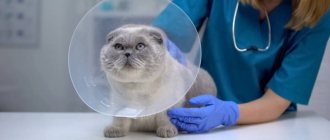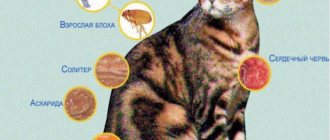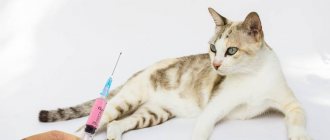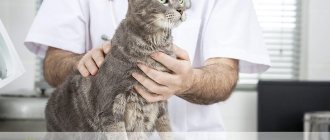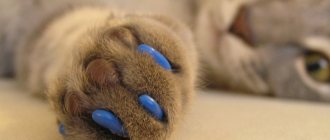Home » Useful Information
Every cat owner knows that a tiny meowing lump, brought into the house, very quickly becomes a full member of the family. Pets give us their unselfish love and affection, and in return we treat them as members of our household, surrounding them with attention and care. But cats are so curious, restless and adventurous that it is almost impossible to protect them from all potential dangers. And these graceful creatures - just like people - sometimes get sick. And a dangerous manifestation of an injury or serious illness in an animal can be internal bleeding.
- 2 What types of bleeding can occur?
2.1 Table: classification of bleeding
- 3.1 Table: external signs of obvious internal bleeding
- 5.1 How the doctor can help
What is bleeding and why is it dangerous for a cat?
A cat's heart pumps a certain amount of blood through its circulatory system. Passing through the vessels, blood supplies the tissues and organs of the animal with the necessary amount of oxygen, participates in local metabolic processes and performs a protective function, fighting local inflammation.
If for any reason the integrity of the walls of blood vessels is compromised, some of the blood will be able to leave its usual route. The process of blood loss from the bloodstream due to damage to the walls of blood vessels is called bleeding.
When bleeding, part of the blood leaves the bloodstream through damage in the walls of blood vessels
If the bleeding is minor and does not recur regularly, the body of a healthy animal is able to cope with it without outside help. In this case, a protective mechanism is triggered: the vessels reflexively contract, and clots of coagulated blood form at the sites of their damage, stopping blood loss. The consequences of such bleeding are usually not dangerous for the cat.
But significant blood loss, which the body lacks its own strength to combat, poses a threat to the life of the animal. As a result of serious bleeding:
- the mechanics of blood circulation are disrupted;
- The blood vessels and heart are not filled enough;
- blood pressure drops;
- acute anemia develops (the number of red blood cells and the level of hemoglobin in the blood sharply decreases);
- the process of oxygen delivery to organs and tissues is disrupted;
- hypoxia (oxygen starvation) of tissues occurs;
- local metabolic processes are disrupted;
- cell death occurs and, as a consequence, the death of the entire organism.
Typically, a cat's death results from the loss of 2/3 to 3/4 of its total blood volume.
Key points
- Most of the causes of gastrointestinal bleeding are amenable to therapeutic correction, although in some cases surgical treatment is indicated.
- Gastrointestinal bleeding is an important cause of blood loss anemia in dogs and cats.
- The most common cause of gastrointestinal bleeding described in dogs and cats is ulceration (ulceration) of the gastrointestinal tract.
- the presence of hematomesis and melena allows one to suspect gastrointestinal bleeding, but these signs are not always observed.
- It is reasonable to use gastroprotectors until the cause of gastrointestinal bleeding is confirmed.
- If a patient has gastrointestinal bleeding, the patient’s hemodynamic (cardiovascular) condition should be examined. If there are signs of shock, immediately begin intensive correction of the condition.
- In cats, the typical cause of ulceration is a neoplastic process.
- In dogs, thrombocytopenia should not be ignored as a cause of gastrointestinal bleeding.
- A common cause of ulceration in dogs is the use of NSAIDs and liver disease.
What kind of bleeding can there be?
Although the cause of blood loss is always a violation of the integrity of the vessel wall, the bleeding itself can be very different.
Table: classification of bleeding
| Classification sign | Types of bleeding |
| Type of damaged vessel |
|
| Time of bleeding |
|
| Direction of blood flow |
|
With external bleeding, blood flows freely outward
At the same time, no matter how the blood loss occurs (drop by drop, in a thin stream or in a pulsating fountain), external bleeding is almost always clearly visible, while internal bleeding is never visible. And this makes internal bleeding especially dangerous.
Symptoms
The disease in an animal occurs with symptoms that can accompany various diseases, so it is necessary to show the pet to a doctor.
If an animal suffers from vomiting and diarrhea and does not drink water at all, this is an alarming sign.
The inability to defecate indicates insufficient fluid levels in the body.
If the oral mucosa is light in color, the saliva is viscous and does not excrete well, this indicates the presence of pathologies.
With existing infectious diseases and inflammation, the temperature can not only rise, but also fall. A sharp change in body temperature leads to profuse sweating and, accordingly, loss of large amounts of fluid.
So, let's name the main symptoms of the disease:
- dry skin;
- lethargy of the animal;
- sunken eyes;
- lack of normal appetite;
- constipation or diarrhea;
- arrhythmia;
- body temperature atypical for an individual;
- saliva viscosity;
- light shade of gums.
https://youtube.com/watch?v=ZABunrwn5Q8
Overt and hidden internal bleeding
Although internal bleeding itself cannot be seen with the naked eye, some types of it are still characterized by certain external manifestations. This type of bleeding is called overt internal bleeding.
Table: external signs of obvious internal bleeding
| Type of obvious internal bleeding | External signs |
| Bleeding in the esophagus | Vomiting blood (blood in the vomit is scarlet) |
| Stomach bleeding | Coagulated dark red or brown blood (“coffee grounds”) in vomit |
| Intestinal bleeding | Vomiting "coffee grounds" (for bleeding in the small intestine) and/or stools that are dark bloody or resemble "coffee grounds" (for bleeding in the lower intestine) |
| Pulmonary hemorrhage | Cough with frothy, bloody sputum |
| Uterine bleeding | Bloody discharge from the loop |
| Kidney bleeding | Blood in any urine |
Any caring owner will definitely pay attention to such alarming manifestations, which means that the animal’s chances of not bleeding to death are quite high. The situation is much worse with so-called hidden internal bleeding.
Hidden internal bleeding
Hidden internal bleeding does not have any immediate manifestations visible to the eye. This is because they occur inside body cavities (such as the abdominal cavity) or organs (such as the spleen) that have no communication with the outside environment. However, such bleeding has certain indirect signs:
- dyspnea;
- pallor of the mucous membranes;
- sudden fatigue;
- lack of appetite;
- weight loss;
- apathy and drowsiness;
- rapidly increasing abdominal volume;
- bruises under the skin.
Pale mucous membranes of the animal (best seen on the inside of the lips and gums) may be a sign of hidden internal bleeding
And the owner must be truly attentive to his pet in order to recognize warning signs in time and help the animal save its life.
Good to know
- Esophagoscopy in dogs and cats
- Protein wasting intestinal disease in dogs. Enteropathy in dogs
- Treatment of hyperlipidemia in dogs with Bezafibrate
- Vomiting, regurgitation in dogs and cats
- Small intestinal transient disorders
- Diseases of the anus and rectum in dogs and cats
- Cholangitis in cats. Identifying, diagnosing and treating cats with neutrophilic, bacterial, lymphocytic or chronic cholangitis
- Diarrhea in dogs and cats
- Hematemesis in dogs and cats
- What are the main causes of protein-losing enteropathy in dogs?
- Main causes of chronic colonic diarrhea in dogs and cats
- How to distinguish chronic small intestinal diarrhea from large intestinal diarrhea?
- Causes of malabsorption in dogs
- Vomiting in cats and dogs
- Causes of acute diarrhea in dogs and cats
- Canine distemper in dogs (forms, diagnosis, symptoms, treatment, therapy)
- Canine exocrine pancreatic insufficiency
- Enteral nutrition for dogs and cats
- Protein-losing enteropathy. Protein enteropathy in dogs
- Lymphocytic cholangitis in cats
- Acute pancreatitis in dogs and cats
- Gastric volvulus in dogs
- Fat metabolism and hyperlipidemia in dogs
Causes of internal bleeding in cats
So, internal bleeding is a multifaceted thing and very dangerous for the health and even the life of a furry pet. But why might it arise?
The causes of internal bleeding in cats are usually divided into traumatic and non-traumatic. And it is worth noting that traumatic causes lead by a significant margin. A blow, a fall from a height, compression - all this can lead to mechanical damage to the integrity of the walls of blood vessels and lead to traumatic internal bleeding.
On the other hand, the presence of diseases in an animal such as atherosclerosis, purulent inflammation, or an oncological tumor can cause pathology of the walls of blood vessels and cause non-traumatic internal bleeding.
A special place in the list of non-traumatic causes of internal bleeding in cats is coagulopathy - a blood clotting disorder. This disorder is often a consequence of poisoning (for example, rat poison).
Finally, we need to mention hematomas. These localized collections of blood typically form initially due to traumatic vascular injury. But, having ruptured and begun to bleed, hematomas can cause non-traumatic internal bleeding.
Any injury - a blow, a fall from a height, squeezing - can cause internal traumatic bleeding in a cat.
How does the disease progress? Forms and their characteristics
Peptic ulcer disease occurs in cats of various breeds and ages. It is not inherited and is not contagious. The disease occurs in pets in different forms:
- Simple (acute). Characterized by sudden attacks and accompanied by severe pain, which intensifies when pressing on the abdominal area.
- Progressive (chronic). Usually asymptomatic, so the owner in the initial stages does not notice any changes in the animal’s appetite, appearance and behavior.
Both forms of peptic ulcer require professional treatment.
When is it time to go to the vet?
The main rule of any cat owner: no panic! Anything can happen in a cat’s life, and you shouldn’t rush around hysterically when you notice a drop of blood on your pet’s paw. But there are things that definitely require a visit to the veterinarian:
- the animal began to bleed blood from its natural orifices;
- The cat's feces are dark red;
- the pet vomits blood;
- blood is visible in the animal's urine;
- one or both eyes of the pet are red;
- The cat has hematomas (voluminous, elastic swelling) under the skin on the paws (leg, thigh, shoulder), on the outer ear, on the oral mucosa or skin.
In these cases, there is no point in delaying a trip to the veterinary clinic. However, before meeting with a doctor, there are some things you can do for your pet yourself:
- minimize stress in the animal by providing it with warmth and peace;
- move the cat very carefully (especially if there is a suspicion of injury);
- apply a cold compress to the suspected area of injury;
- Do not give your pet water, food, medication, or try to administer an enema.
And most importantly, remember: you cannot cope with internal bleeding on your own! In these cases, all hope lies with the veterinarian.
At the slightest suspicion of internal bleeding in a cat, a visit to the veterinarian is inevitable.
How can the doctor help?
The first task of a specialist is to conduct a competent diagnosis. After all, for example, the visible manifestations of gastric and intestinal bleeding are very similar, and in really serious cases, the life of your pet depends on the speed of making a diagnosis and taking adequate measures.
Typically diagnosis includes the following steps:
- taking an anamnesis (you will have to tell the whole medical history, any details are very important);
- physical examination of the animal;
- X-ray of the abdominal cavity (allows us to detect the presence of free fluid in the abdominal cavity, as well as massive formations such as tumors and hematomas);
- puncture of the abdomen using a needle and syringe (to obtain a sample of fluid for analysis) and analysis of the resulting fluid;
- blood tests (clinical analysis shows the presence of anemia, biochemical analysis determines the presence of damage to internal organs, coagulogram shows a blood clotting disorder);
- ultrasound examination of the abdominal cavity (allows us to detect the presence of tumors in the abdominal cavity);
- CT or MRI (allows you to visualize neoplasms that are inaccessible to ultrasound).
The physical (primary) examination of the animal consists of mandatory steps, performed in any order. This is mainly a visual examination and palpation (palpation), in which the specialist uses his senses and uses vision, touch, smell and hearing.
Immediately after diagnosis, the veterinarian prescribes treatment, which directly depends on the cause of the bleeding and the general condition of the animal. The most typical stages of such treatment are the following:
- abdominal puncture (pumping out excess fluid that interferes with normal breathing);
- intravenous administration of saline and plasma preparations to maintain the required blood pressure;
- blood transfusion (blood transfusion) with significant blood loss;
- an increase in intra-abdominal pressure to help stop bleeding (using compression bandages);
- oxygen therapy;
- anesthesia;
- administration of vitamin K (for coagulopathy);
- emergency surgery if treatment does not give results (does not stop bleeding) or in cases of neoplasms.
The result of the operation can be both the actual stopping of internal bleeding and the removal of an organ damaged by injury or an oncological process that caused blood loss. The postoperative period takes place in a hospital setting, where the animal receives the necessary antibacterial therapy and transfusions of plasma and blood preparations.
Features of the diet for ulcers
Therapy for peptic ulcer disease in a cat is associated with changes in its diet and nutrition. It is recommended to feed your pet 4-5 times a day, but in small portions. Make sure that food is at room temperature: too hot or cold foods can cause an exacerbation of the disease.
Recommended food:
- liquid rice porridge,
- other slimy porridges (for example, oatmeal),
- weak meat broths (chicken, turkey),
- dairy and fermented milk products (for example, kefir, low-fat cottage cheese, cream),
- boiled eggs,
- boiled vegetables (carrots, broccoli).
It is forbidden to give cheap dry food, canned food, or food from the table. If you still have questions related to your cat's nutrition, be sure to consult your veterinarian!
Preventive actions
To prevent anemia in a pet, the owner must follow a number of simple rules:
You can provide your animal with complete and balanced nutrition and get specific recommendations regarding the diet of a particular breed from your veterinarian. A cat's diet should be rich in protein, so beef, chicken and turkey are a must. Also pamper your pet with offal twice a week. The liver is especially useful. Fermented milk products will ensure proper functioning of the intestines, and introduce vegetables as a source of iron, copper and vitamins. Give your pet the opportunity to splash out its energy; do not limit its activity. Timely implementation of anthelmintic measures
Typically, anti-parasite medications need to be given to your cat once a quarter. Vaccinating your animal will help prevent diseases that cause anemia. Avoid contact between your pet and its stray relatives. Pay special attention to safety. All toxic substances and medications must be kept out of reach of the animal
When treating a living space with insecticides, it is necessary to exclude the cat from being there until the time recommended by experts. If signs of illness are detected, immediately show the cat to a doctor. It is more effective to treat any disease in the first stages. Therefore, you should not delay going to the veterinarian. The ideal option would be systematic preventive examinations by a specialist.
Forecast
Anemia in cats is a serious disease that, if ignored, can be fatal. Therefore, when the first signs appear, visit your veterinarian as soon as possible. The earlier the disease is diagnosed, the better the prognosis.
It is important to remember that the correct diagnosis can be made by a doctor when conducting appropriate laboratory tests and studies. Acquired anemia responds well to adequate treatment, so strictly follow all recommendations received
To avoid relapse, do not neglect preventive measures. If anemia is caused by the presence of an oncological process, then in this case the prognosis will depend on its severity. A similar situation will occur with an autoimmune disease.
Signs of rat poison poisoning
In our country, the most common cause of poisoning of domestic cats are various rodenticides (rat poisons). These products contain different active ingredients, therefore their effect on the animal’s body is different. The most common cause of poisoning is anticoagulant rodenticides. The mechanism of their toxic action lies in the suppression of the production of vitamin K1, which is responsible for normal blood clotting. After ingestion, the animal may feel normal for 3-5 days until vitamin K1 reserves are exhausted. After which the symptoms of rat poisoning begin to appear:
- heavy bleeding even with minor injuries;
- internal bleeding;
- extensive hematomas;
- black chair;
- nosebleeds;
- blood in urine;
- rapid heartbeat;
- shortness of breath;
- lethargy;
- pallor of mucous membranes and skin;
- fainting;
- swelling in the joint area;
- abdominal pain;
- shiver.
The toxicity of rodenticides increases with accumulation if they enter the body several times. A cat can become poisoned by eating bait or poisoned rodents.
Treatment
A disease in which a cat vomits blood will not cure on its own. A visit to the veterinary clinic is inevitable. But the owner does not always have the opportunity to do this immediately. This condition cannot be ignored, otherwise death is possible.
What can an owner do if a cat is vomiting blood?
With such a pathology, the owner is severely limited in the ability to provide first aid. He can only put the cat on a starvation diet for 1-2 days and ensure complete rest. Clean drinking water during this period should be available and in abundance.
Attempts to feed the cat will only worsen its situation, since food masses further irritate the damaged gastrointestinal mucosa.
What can a doctor prescribe if a cat is vomiting?
After confirming the diagnosis, the veterinarian prescribes treatment. Usually this is a detailed diagram of the use of procedures and medications under the supervision of a specialist.
If the cause of vomiting with blood in a cat is minor damage to the blood capillaries of the mucous membranes of the gastrointestinal tract, then conservative treatment is prescribed (diet, increased consumption of clean drinking water, mild medications to stabilize blood clotting, restoratives, vitamins, antibiotics - if necessary, at the discretion of the doctor) . In case of poisoning with anticoagulant poisons, cats are prescribed Vicasol intramuscularly (vitamin K), starting with a loading dose and gradually reducing the volume of the drug. Symptomatic therapy is also carried out (adsorbents, blood replacement droppers to restore blood volume and avoid dehydration). After eliminating the main symptoms, restorative therapy is carried out. In general, the prognosis is unfavorable. Gastrointestinal neoplasms in all animal species can only be cured by surgery. A distinctive feature of neoplasms in the gastrointestinal tract is their long development. This allows them to be successfully removed. For severe forms of inflammation in the large intestine, cats are treated with immunosuppressive drugs (to suppress the activity of the immune system). But diagnosed lymphoma is treated in a comprehensive manner - after surgical removal, chemotherapy is prescribed. If foreign bodies are detected in the gastrointestinal tract or respiratory organs, surgical intervention is performed (abdominal or laparoscopic). After surgical treatment, proper postoperative care is required (elimination of physical activity, diet). Treatment of bleeding in the lungs in cats involves emergency hospitalization under the supervision of a veterinarian. Antitussive drugs are used (to reduce the mechanical effect on lung tissue), coagulants to increase blood viscosity and coagulability, as well as restorative drugs. If necessary, blood replacement therapy is carried out. When vomiting during infectious diseases, cats are, if possible, given specific passive antibodies. The rest of the treatment is reduced to symptomatic therapy, the use of painkillers, restoratives, immunostimulating, vitamin preparations
An important place in such treatment is occupied by the period of rehabilitation (recovery) after an illness.
Diagnosis of anemia
Based on its results, the doctor will understand whether hemoglobin is normal and what the erythrocyte sedimentation rate is.
Blood chemistry.
Allows you to determine the level of iron in the blood. A low rate allows one to suspect the presence of a disease.
Hematological examination.
Allows you to determine the number of immature red blood cells.
- Blood clotting testing.
- Urine and stool analysis.
The biomaterial may contain blood and stercobilin. If a viral or infectious nature of the disease is suspected, the doctor will prescribe an additional test.
To obtain a more accurate picture, you may need an ultrasound examination of the kidneys and x-rays to determine tumor processes. A comprehensive diagnostic approach allows you to make a correct diagnosis and develop an effective treatment path.
I would like to draw attention to the fact that it is unacceptable to independently diagnose a cat with anemia and treat it without a doctor’s prescription. In this case, the consequences can be dire
Self-prescribed iron supplements will simply be useless if there is internal bleeding.
Can you help your pet yourself?
When the first signs of blood loss appear in a cat, measures must be taken to stop it.
Stopping bleeding can be temporary or permanent.
By using a temporary stop, you can prevent critical blood loss and gain time for a final stop. Methods for temporarily stopping external bleeding include: applying a pressure bandage or tourniquet, pressing the artery with a finger.
The bandage can be used for capillary types of bleeding, minor venous and arterial. A napkin is placed on the site of the injury, cotton wool rolled into a tight ball is placed on top, and then bandaged tightly. A pressure bandage is the most popular and effective method of temporarily stopping bleeding in pets.
When you have temporarily stopped the bleeding, you need to immediately go to the veterinarian or call him to your home. If you suspect internal bleeding, then you don’t need to do anything yourself so as not to worsen the existing situation. Immediately show your pet to a specialist, in this case, with moderate injuries, there is a chance that the fluffy one can be cured and returned to his previous healthy life.
Any bleeding in a pet causes strong emotions in owners: from anxiety to panic. Nothing human is alien to cats, and therefore they are susceptible to nosebleeds no less than people. Sometimes this is a single manifestation of some temporary disorder, sometimes it is a signal of a serious illness.
Let's figure out why a cat's nose bleeds when sneezing, and how you can help it.

